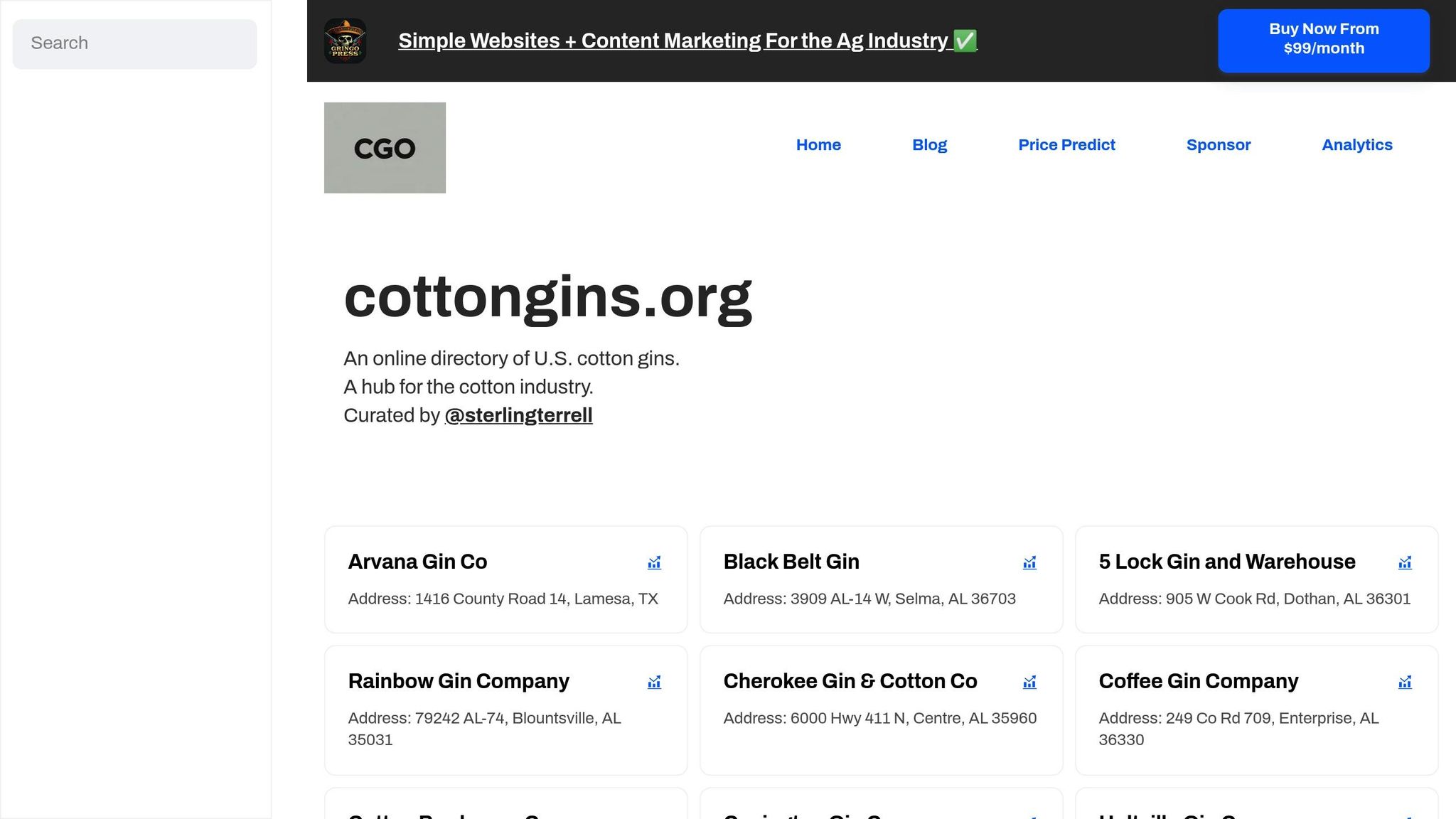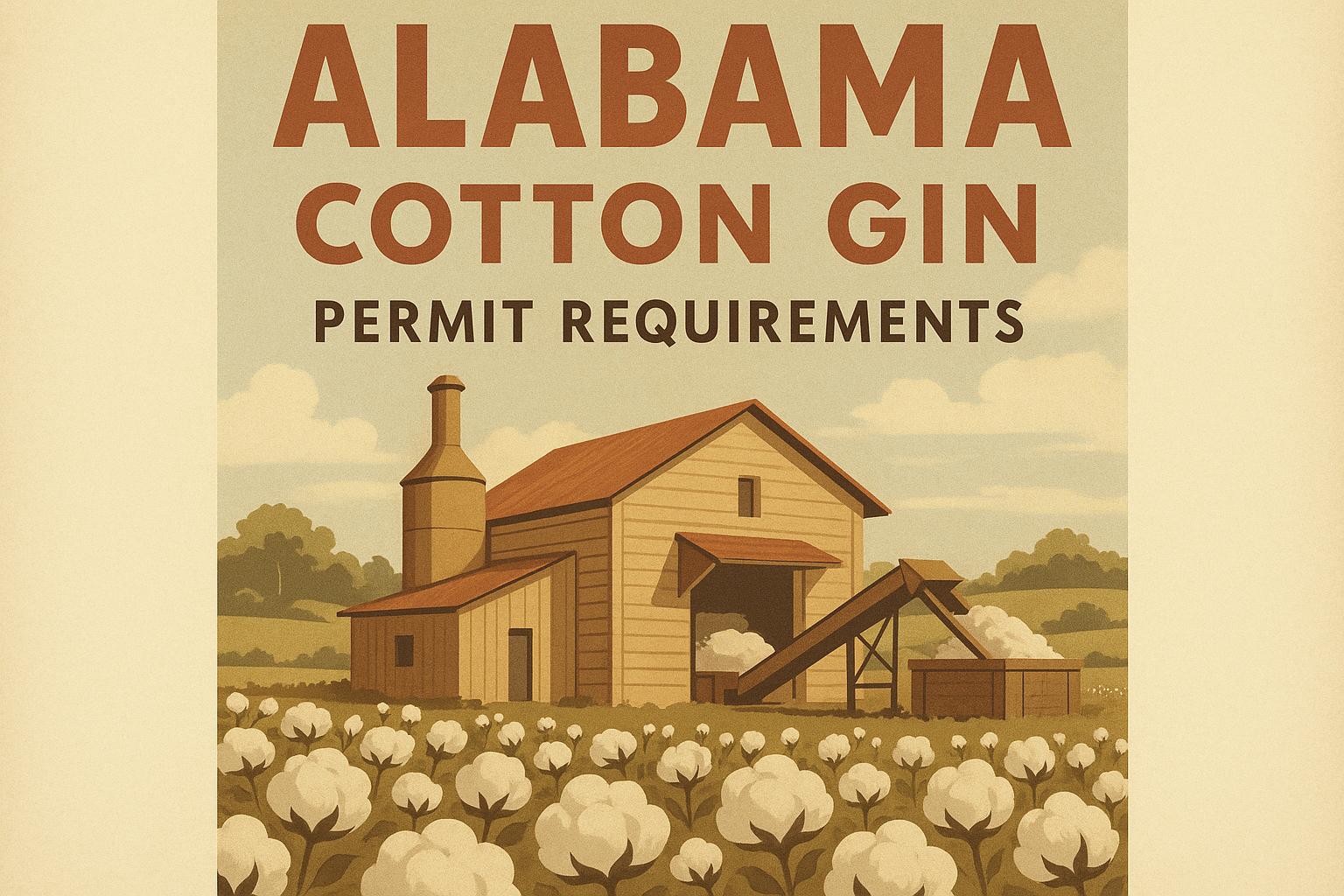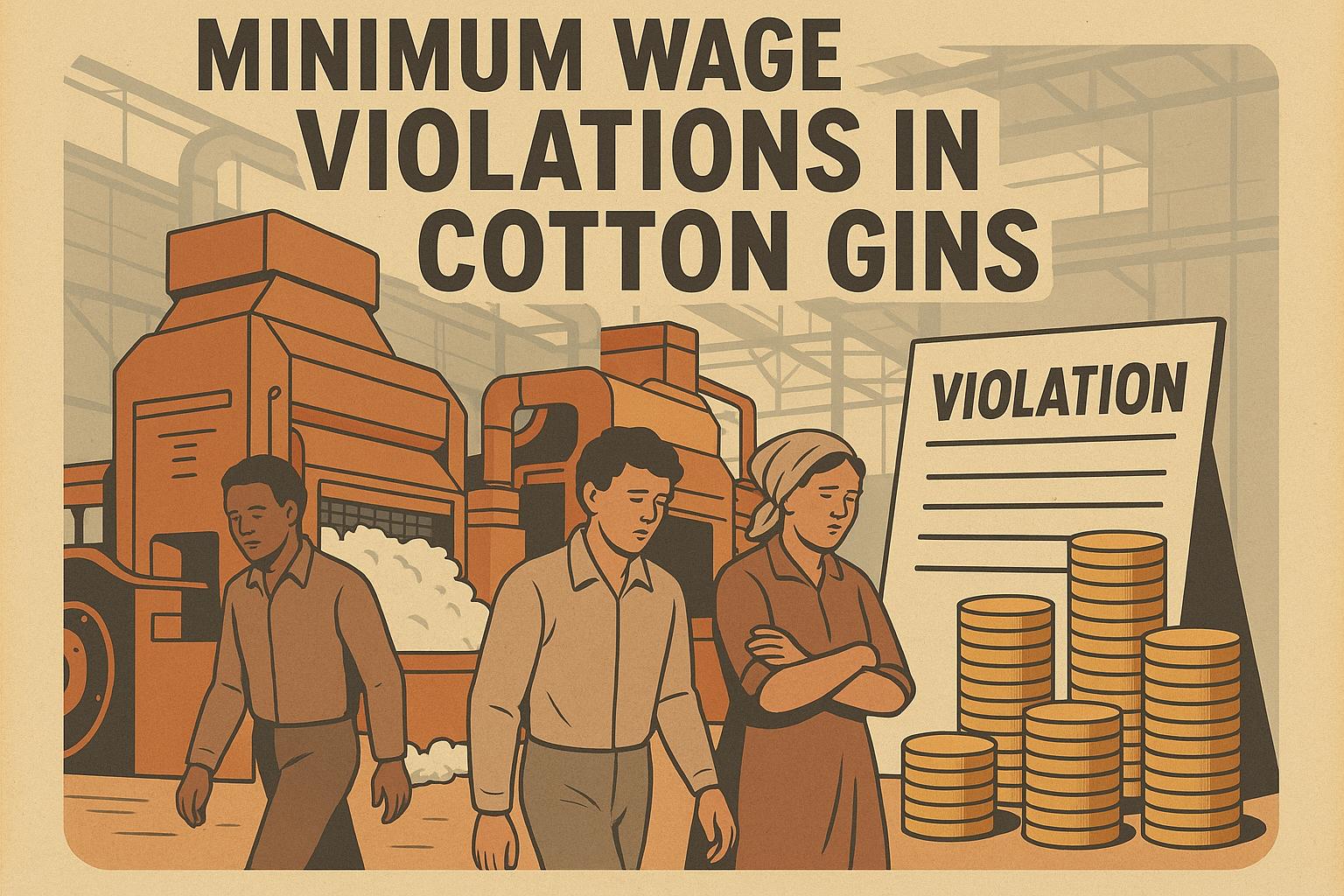Cotton gins in the U.S. must follow strict reporting rules to comply with federal and state regulations. These requirements are designed to ensure accurate production tracking, policy-making, and assessment collection. Key agencies like the USDA NASS, AMS, and The Cotton Board oversee different aspects of this process, from production data to producer accountability and quality tracking. Gins use tools ranging from manual logs to automated software to meet these demands. Missing deadlines or inaccurate reporting can result in penalties, making proper documentation and timely submissions critical for smooth operations. Here's a breakdown of what gins need to know:
- Data Collection: Includes bale counts, producer details, cottonseed prices, and quality metrics.
- Agencies Involved: USDA NASS (production data), AMS (quality classification), and The Cotton Board (assessments).
- Tools Used: Paper logs, spreadsheets, and specialized software for tracking and reporting.
- Deadlines: Vary by agency and state, with penalties for late or incomplete submissions.
- Documentation: Includes environmental permits, fire safety records, and bale traceability.
How Cotton Gins Collect Data
Cotton gins use a mix of methods to gather the detailed data they need throughout the season. These methods range from manual tracking to digital tools and specialized software, tailored to meet the specific requirements of various reporting agencies. This thorough approach ensures compliance with precise reporting standards.
What Data Cotton Gins Must Collect
The data cotton gins are required to collect depends on the reporting agency, with each agency having its own specific needs.
For the NASS Cotton Ginnings Survey, gins monitor production metrics throughout the season. They report the number of bales ginned so far and provide an estimate of remaining bales to be processed. Additionally, gins must disclose the average price paid to producers for cottonseed. At the season’s end, NASS requires details such as the total pounds of lint cotton produced from ginned bales, the average weight per bale, and the number of saw and roller ginning plants in operation. For a subset of gins, NASS also collects data on total pounds of cottonseed produced, cottonseed delivered to oil mills, and cottonseed used for feed, seed, or other purposes.
The Cotton Board's End-of-Season Report shifts focus to producer accountability. This report demands an alphabetical list of producer names, their addresses, and the number of bales ginned for each producer during the season.
For quality tracking, the AMS National Database requires gins to record identification details for each bale, including their gin code.
Forms and Software for Data Collection
Cotton gins rely on a variety of systems to efficiently capture and manage the required data. The choice of tools often depends on the gin’s size, technological resources, and the complexity of its reporting obligations.
- Paper-based systems remain a staple for smaller operations. These systems typically involve daily log sheets where operators manually record bale counts, producer details, and weight measurements. Even with advancements in technology, paper records serve as a reliable backup for digital systems.
- Digital tools, such as spreadsheets, are widely used to organize producer data, track bale counts, and calculate totals for reporting. These tools simplify the preparation of reports for both the NASS survey and the Cotton Board.
- Specialized software automates many aspects of data collection. These programs can integrate directly with ginning equipment to automatically record bale weights, assign sequential numbers, and link production data to individual producers. They also generate reports formatted to meet agency requirements, reducing manual effort and minimizing errors.
For environmental compliance, some states, like South Carolina, require applications to be submitted through ePermitting platforms.
The key to effective data collection lies in maintaining consistent procedures from the start of the season. Procrastination can lead to incomplete reports and potential penalties. By implementing these methods early, gins can ensure accurate, timely reporting while meeting strict deadlines and record-keeping standards.
Meeting Reporting Deadlines
Cotton gins are required to meet reporting deadlines set by federal, state, and local agencies. Submitting reports on time helps avoid penalties and ensures smooth operations without interruptions.
When Reports Are Due
Reporting deadlines depend on the agency and the type of information being submitted. For instance, some federal surveys and industry reports align with the ginning season and require periodic updates during operations. On the other hand, reports tied to permits - such as those for environmental compliance - might follow quarterly or annual schedules. Staying organized and aware of these varying timelines is crucial.
Penalties for Missing Deadlines
Failing to meet deadlines can lead to fines, stricter compliance requirements, or even permit suspensions. Repeated violations can damage a gin's reputation and make securing financing or insurance more challenging. To stay on top of these obligations, many gins rely on internal tracking systems and assign specific staff members to oversee deadlines.
Next, we’ll look at record-keeping practices that help ensure accurate reporting.
Documentation and Record-Keeping Requirements
Keeping accurate records is crucial for ensuring compliance and staying prepared for audits. Cotton gins are required to maintain detailed documentation that backs up their submissions and proves adherence to regulatory guidelines. This documentation is designed to work hand-in-hand with earlier data collection and reporting processes.
Permits and Packaging Standards
Cotton gins operate under various permits, each with its own documentation requirements. For example:
- Environmental permits: These often require records of air emissions, waste disposal, and water usage. Daily logs, maintenance schedules, and calibration certificates are commonly included.
- Fire safety permits: These demand documentation of inspections, maintenance activities, and staff training. Records of fire suppression system tests and storage capacity are also necessary, as permits often specify how much cotton can be stored on-site.
Packaging standards introduce additional documentation needs. Gins must track the origin of each cotton bale, including field locations, harvest dates, and any treatments applied to the crop. This level of traceability is vital for addressing quality concerns or meeting buyer requests for sourcing details. Alongside this, weight tickets, moisture readings, and grade classifications must be archived for every bale processed.
For gins operating under USDA warehouse licenses, inventory records are another critical component. These include bale identification numbers, storage locations, and movement logs, all of which must be updated daily. Federal inspections rely on these records, and any discrepancies between physical inventory and documentation could lead to a suspension of the license.
How to Verify Report Accuracy
Ensuring the accuracy of reports is all about cross-checking and validation. For instance, production reports should match up with purchase records, ginning schedules, and shipping documents. If inconsistencies arise, they signal the need for further review.
Internal audits and software tools play a big role here. Regular audits help catch transcription errors, missed entries, or unusual data patterns. Many systems also include automated calculations to ensure that summary reports correctly reflect the underlying data.
In some cases, third-party verification is required - this is especially true for reports tied to organic or specialty cotton certifications. Independent inspectors review the documentation, observe operations, and confirm that reported practices align with certification standards. These inspections are typically annual but can also be triggered by customer complaints or regulatory concerns.
To guard against data loss, backup digital copies are stored both on-site and in the cloud, often retained for at least seven years. These practices provide a solid foundation for meeting the diverse reporting requirements that states may impose, as discussed further in the next section.
sbb-itb-0e617ca
State-by-State Reporting Differences
Federal guidelines set a baseline for cotton gin reporting, but state-level regulations bring added layers of complexity, especially across the Cotton Belt. For businesses operating in multiple states or serving producers in different regions, understanding these variations is essential. Let’s look at some key differences in state reporting requirements.
Comparing State Reporting Rules
Reporting deadlines vary significantly from state to state. For instance, Texas operates on a unique timeline, with initial reporting beginning on August 1 and September 1. In contrast, states like Georgia and Mississippi require semi-monthly updates starting September 15 through February 1, followed by an end-of-season report in March. These differences can pose logistical challenges for cotton gins with facilities in multiple states. A gin operating in both Texas and Georgia, for example, must juggle two distinct reporting calendars.
USDA FSA and RMA crop acreage reporting add another layer of complexity. While July 15 is a key deadline for most crops, the actual timelines "vary by crop and by state and county". FSA reports typically require details such as crop type, intended use, acreage, planting dates, and irrigation practices. This means operators must tailor their data collection and reporting systems to meet the specific requirements of each state.
Shifts in planting data also impact reporting demands. For example, in 2025, Texas saw a significant drop in upland cotton acreage - 250,000 fewer acres compared to the previous year. Georgia and Mississippi followed with decreases of 100,000 acres or more from their 2024 totals. Such changes push gins to adjust their reporting processes to reflect these fluctuations.
On the other hand, Cotton Board reporting requirements remain consistent across all 17 cotton-producing states. Assessment rates, gin report formats, and monthly handler reporting deadlines are uniform, whether you're operating in Texas, Georgia, or Mississippi.
Using cottongins.org for Local Compliance

To manage these state-specific nuances, the cottongins.org directory serves as an invaluable tool. It provides a comprehensive listing of cotton gin locations by county and state, helping industry professionals understand the regulatory landscape in different areas. This resource is particularly helpful for operations entering new territories or expanding into unfamiliar regions.
The directory’s state-by-state layout makes it easy to locate nearby facilities with similar compliance requirements. For new businesses or those navigating multi-state operations, this approach simplifies the process of identifying shared challenges and best practices.
Moreover, cottongins.org allows users to submit updates for new gin facilities, ensuring the directory stays current. For companies managing operations across multiple states, this platform offers a centralized way to map out reporting obligations and align them with the practices mentioned earlier. It’s a practical starting point for navigating the diverse regulatory frameworks that affect cotton gins nationwide.
Summary of Cotton Gin Reporting Requirements
Cotton gins are required to follow a variety of reporting guidelines, ensuring compliance with both federal and state regulations. The Cotton Board acts as the main federal authority overseeing these requirements. For gins that serve as the collecting handler for all their ginned bales and have submitted all assessments, a certificate can be used as an alternative reporting method.
Collecting handlers must file monthly assessments using approved forms and keep detailed, verifiable records to back up their submissions.
Operational safety is just as important as accurate reporting. Gins must comply with OSHA, SPCC, and DOT standards. This includes implementing fire prevention measures, conducting regular inspections and testing, and providing employee training. For operations involving hazardous material transport, adherence to U.S. Department of Transportation regulations is essential, including the creation of a transportation security plan.
To meet these requirements effectively, gins need to focus on preparation. This involves setting up reliable data collection systems, keeping well-organized records throughout the season, and staying updated on federal regulations. Employees operating powered industrial equipment should also be fully trained in USDOL OSHA guidelines to maintain a safe work environment.
FAQs
What happens if a cotton gin misses reporting deadlines or submits incorrect data?
If a cotton gin misses reporting deadlines or provides incorrect information, it could face civil fines, financial penalties, or even legal repercussions. The level of these consequences varies based on the nature of the violation and the governing regulations. Staying compliant with state and federal reporting requirements is essential to avoid these penalties.
What factors influence a cotton gin's choice between paper-based and digital systems for data collection and reporting?
Cotton gins choose between paper-based systems and digital tools depending on factors like efficiency, accuracy, and available resources. Paper systems remain popular for their straightforwardness and ease of use, especially in operations where simplicity is key. However, many gins are shifting to digital tools, which can streamline workflows and ensure better compliance with state regulations.
Digital tools, such as automated sensors and data-tracking software, bring benefits like real-time reporting and a reduced chance of human error. Despite these advantages, some gins continue to rely on paper systems due to budget constraints or limited infrastructure. As the industry progresses, digital solutions are gaining traction for their ability to simplify processes and improve data management.
What state-specific regulations should cotton gins know when operating in multiple states within the Cotton Belt?
State regulations for cotton gins differ widely throughout the Cotton Belt. These variations can involve everything from reporting requirements to how data is collected and when crop information must be submitted. Understanding the specific rules in your state is crucial to staying compliant and avoiding penalties.
For instance, one state might prioritize detailed reports on crop yields and quality, while another could focus more on operational or environmental data. Keeping track of these differences is key to running your operations efficiently. To stay informed, consider reaching out to local regulatory agencies or tapping into industry resources for the latest updates.


